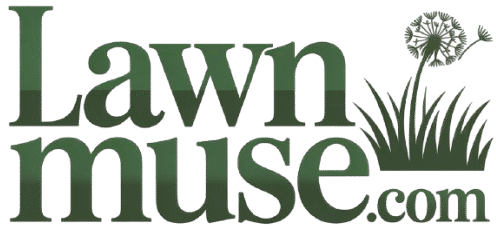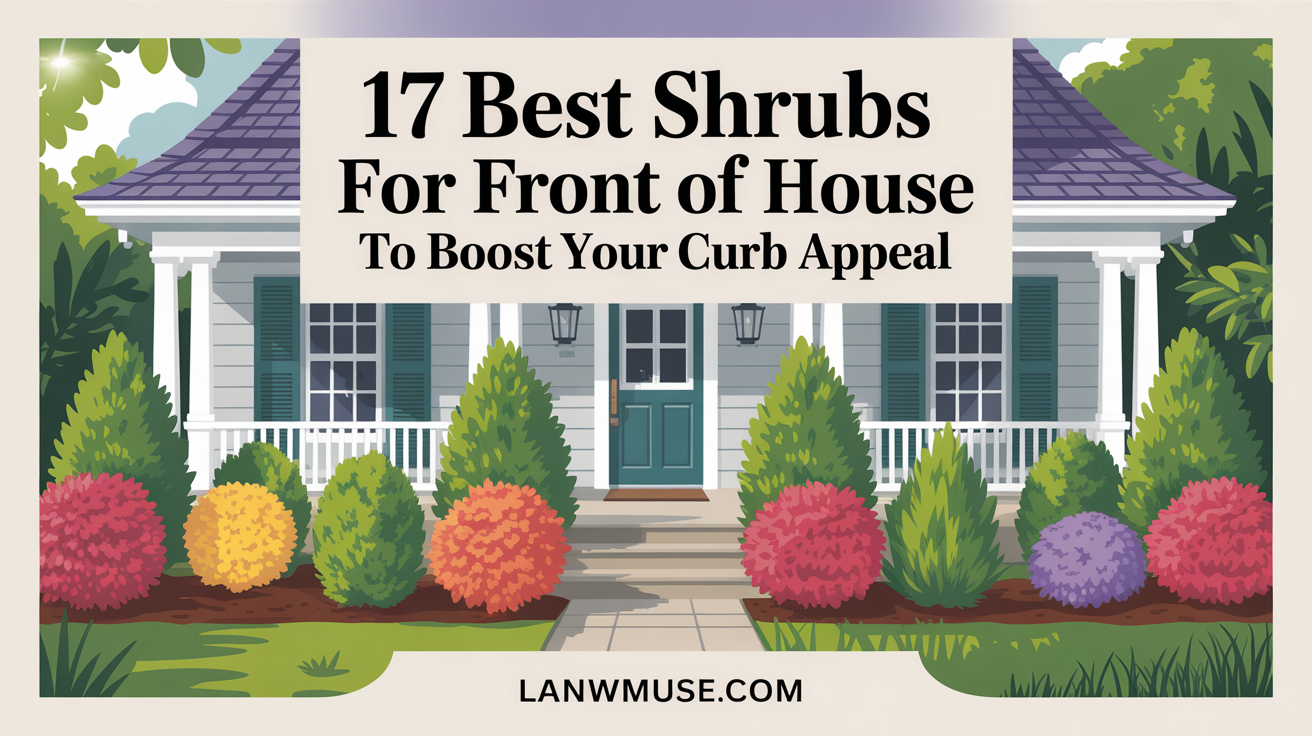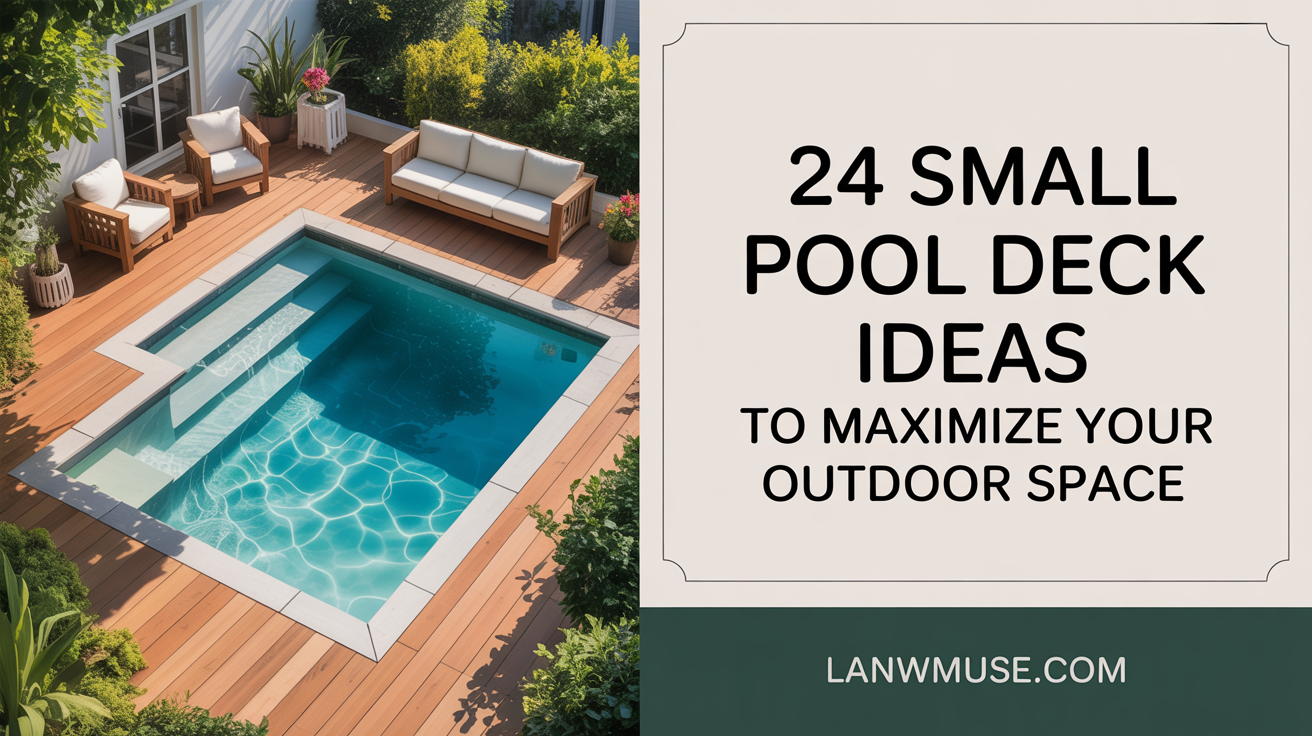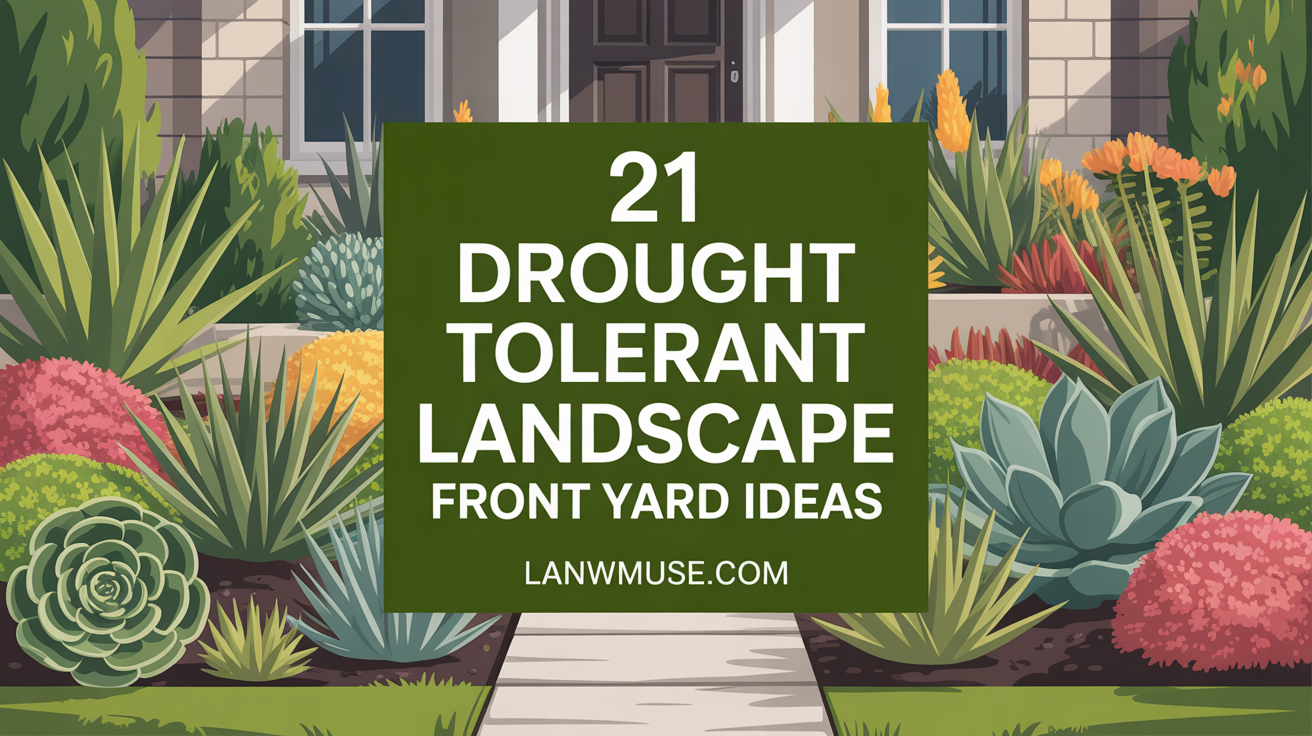Your front yard is the first impression guests and passersby get of your home—and nothing adds charm, color, and structure quite like well-chosen shrubs. Whether you’re aiming for a classic, manicured look or a lush cottage garden vibe, shrubs play a vital role in defining your home’s personality from the street. From evergreen varieties that provide year-round appeal to flowering favorites that light up your landscape seasonally, there’s a shrub for every aesthetic and climate.
In this guide, we’ve rounded up 17 of the best shrubs for the front of the house, chosen for their beauty, versatility, and ability to boost curb appeal. Whether you’re a seasoned green thumb or just getting started with landscaping, you’ll find practical insights and plant picks that can transform your entryway into a welcoming masterpiece.
1. Boxwood (Buxus spp.)
Why It’s a Favorite:
Boxwoods are a classic choice, beloved for their tidy, evergreen foliage and easy shaping. Whether used as a low hedge or standalone accent, they bring structure and elegance.
- Suitability: Compact and easy to shape, ideal for formal or traditional front yard designs.
- Hardiness Zones: 5–9
- Special Attributes: Evergreen, deer-resistant, low maintenance.
Pro Tip: Use boxwoods to frame walkways or line your foundation beds for a polished, year-round look.
More Insight:
Boxwoods are one of the most versatile evergreens, working well in both sun and partial shade. Their slow growth makes them perfect for topiary and hedging. They pair beautifully with perennials and seasonal flowers, offering a permanent green backdrop. Despite their low-maintenance label, proper airflow and spacing help prevent common issues like boxwood blight.
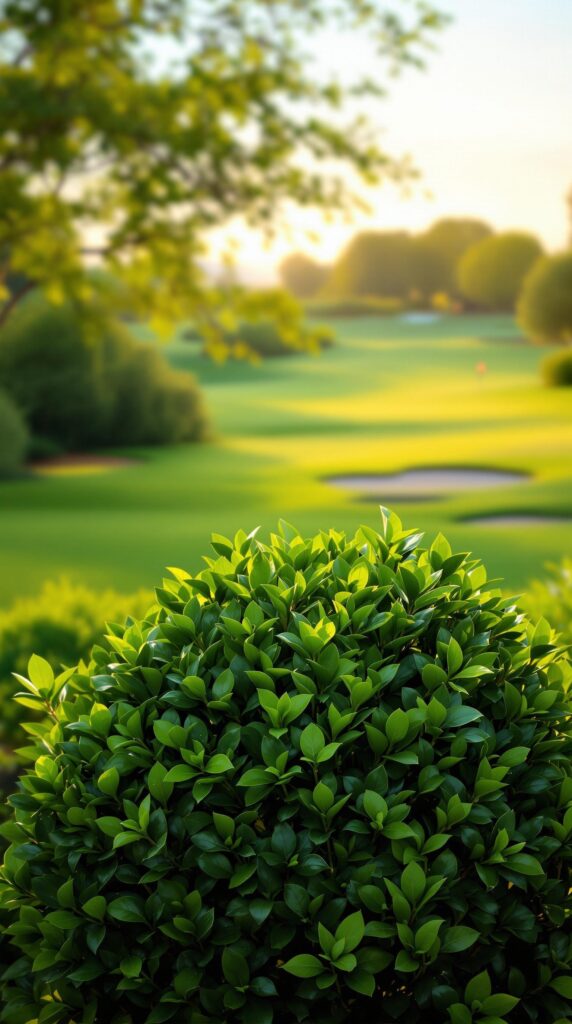
2. Forsythia
Why It’s a Favorite:
Forsythia is a spring superstar, exploding with golden-yellow blooms before the leaves appear, signaling the start of warmer weather.
- Suitability: Great for naturalized borders or as a colorful accent.
- Hardiness Zones: 5–8
- Special Attributes: Fast-growing, early bloomer, deer-resistant.
Pro Tip: Plant Forsythia in groups for a stunning spring display that wakes up your entire front yard.
More Insight:
Forsythia is ideal for informal landscapes, where its arching branches can spread naturally. It grows quickly, often reaching 6–10 feet, making it excellent for fast privacy or filling space. Prune just after flowering to control size and shape. Forsythia also tolerates a variety of soils, though it thrives best in well-drained areas with full sun.
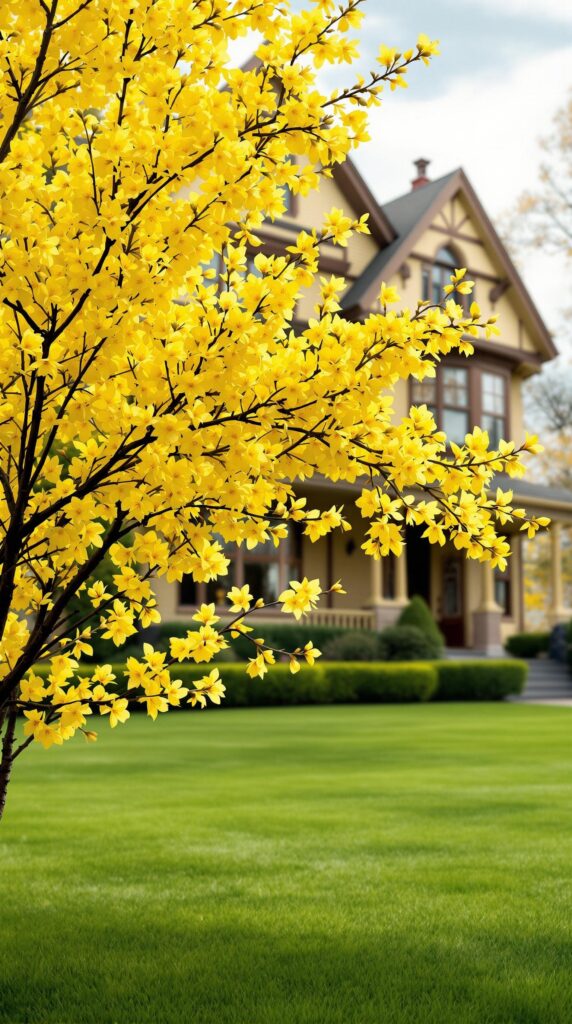
3. Lilac (Syringa spp.)
Why It’s a Favorite:
Few shrubs are as fragrant and nostalgic as the lilac. Its clusters of pastel blooms and sweet scent make it a timeless choice.
- Suitability: Ideal for cottage or traditional gardens.
- Hardiness Zones: 3–7
- Special Attributes: Fragrant, attracts pollinators, seasonal interest.
Pro Tip: Give lilacs full sun and room to breathe to encourage plentiful blooms.
More Insight:
Lilacs are especially valued for their bold springtime presence. They can reach up to 12 feet depending on the variety and spacing. Regular pruning is essential to prevent them from becoming woody and to promote new growth. For smaller spaces, consider dwarf varieties like ‘Bloomerang’ which also rebloom in summer.
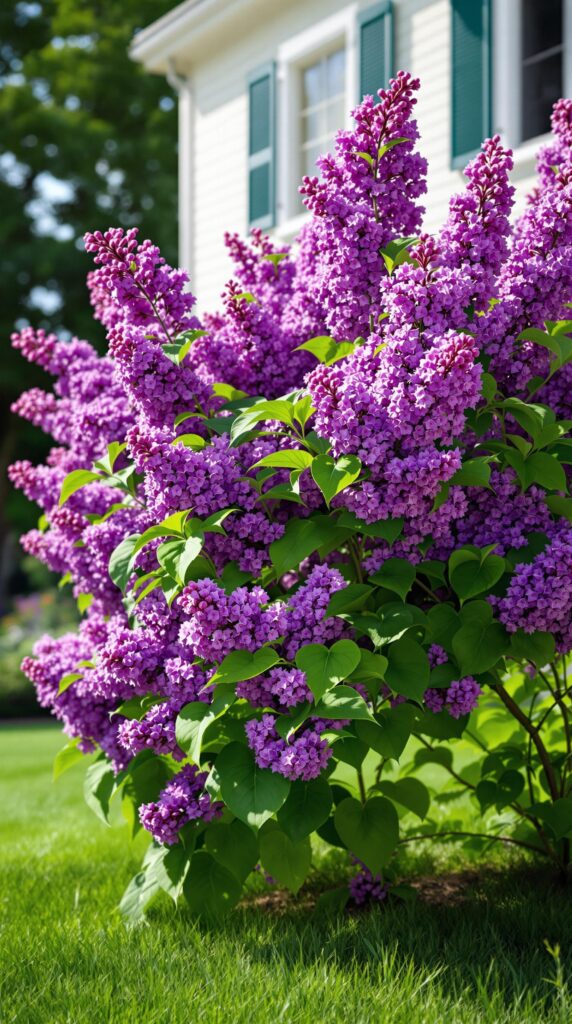
4. Hydrangea
Why It’s a Favorite:
With big, blousy blooms in shades of blue, pink, white, and even green, hydrangeas are the darlings of front-yard landscaping.
- Suitability: Great for foundation plantings or mixed borders.
- Hardiness Zones: 3–9 (varies by species)
- Special Attributes: Seasonal color, some varieties rebloom, tolerant of partial shade.
Pro Tip: Soil pH can affect bloom color in certain varieties like Hydrangea macrophylla—acidic soil yields blue flowers, while alkaline soil produces pink.
More Insight:
Hydrangeas add drama and softness, often growing between 3 to 6 feet tall and wide. They prefer moist, well-draining soil and benefit from mulch to retain moisture. Popular cultivars like ‘Limelight’ and ‘Annabelle’ are prized for their reliable blooms and resilience. Hydrangeas also look stunning when used in mass plantings or layered with evergreens for contrast.
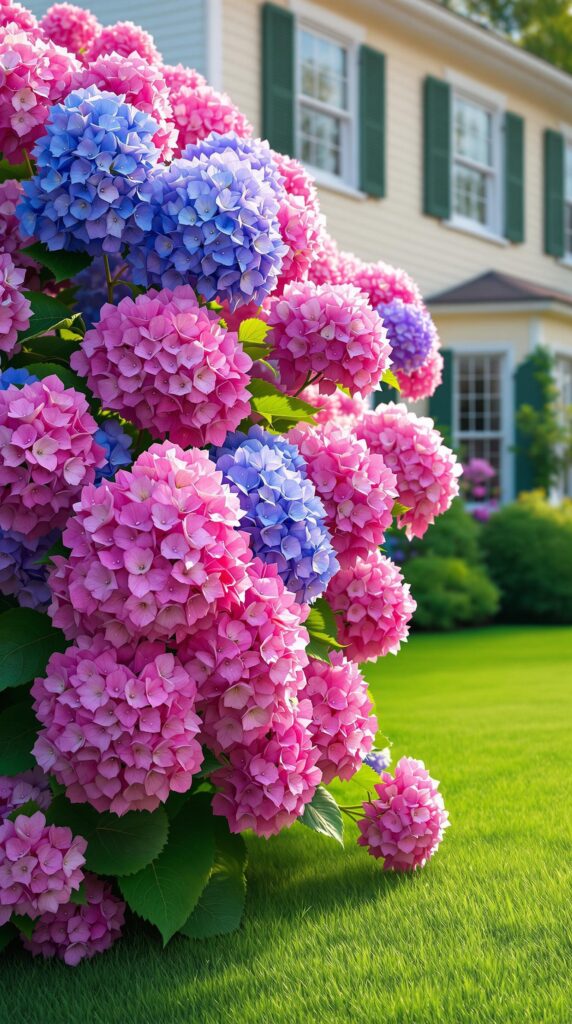
5. Azalea
Why It’s a Favorite:
Azaleas provide an explosion of color in spring and work beautifully in shaded or woodland front yards.
- Suitability: Excellent for borders and foundation plantings.
- Hardiness Zones: 6–9
- Special Attributes: Bloom in vibrant colors, thrives in partial shade, compact size.
Pro Tip: Choose evergreen varieties for longer-lasting greenery after the blooms fade.
More Insight:
Azaleas flourish in dappled shade with slightly acidic soil. Their shallow roots make them sensitive to drought, so consistent watering is key during dry periods. The range of colors—from fuchsia to coral to white—makes them ideal for adding flair to darker corners of your landscape. Try grouping different varieties for a cascading bloom effect in spring.
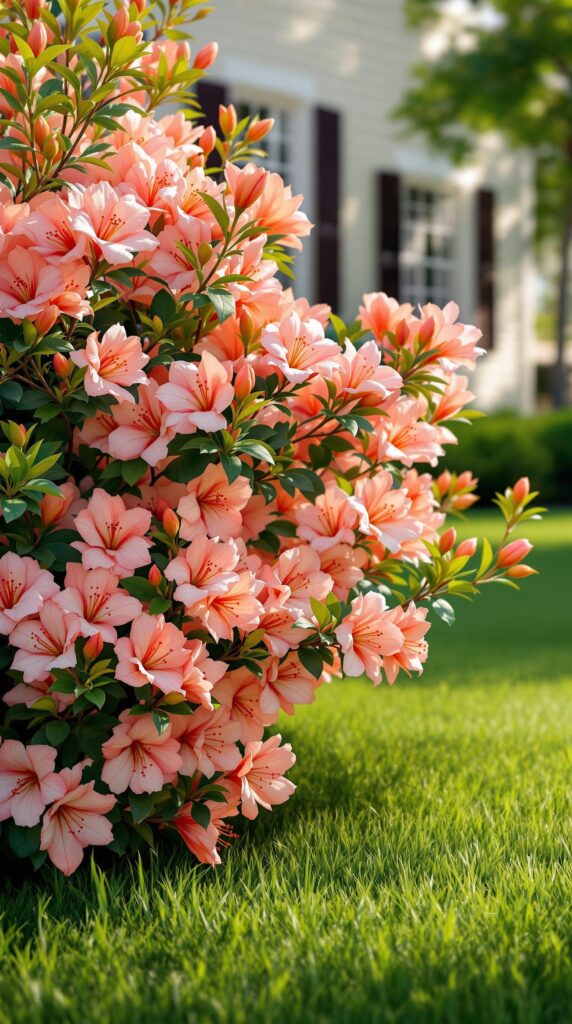
6. Japanese Maple (Acer palmatum)
Why It’s a Favorite:
Technically a small tree or large shrub, the Japanese maple adds striking texture and color to your front yard.
- Suitability: Perfect focal point near entryways or in island beds.
- Hardiness Zones: 5–8
- Special Attributes: Gorgeous foliage, compact growth, seasonal interest.
Pro Tip: Protect from harsh afternoon sun to avoid leaf scorch, especially in hotter zones.
More Insight:
With dozens of cultivars ranging in leaf shape, size, and color, Japanese maples can be tailored to nearly any front yard. Varieties like ‘Bloodgood’ offer deep red leaves that stand out in any setting. They prefer slightly acidic, well-drained soils and do best when sheltered from wind. Their graceful habit also makes them a favorite for zen or Asian-inspired garden styles.
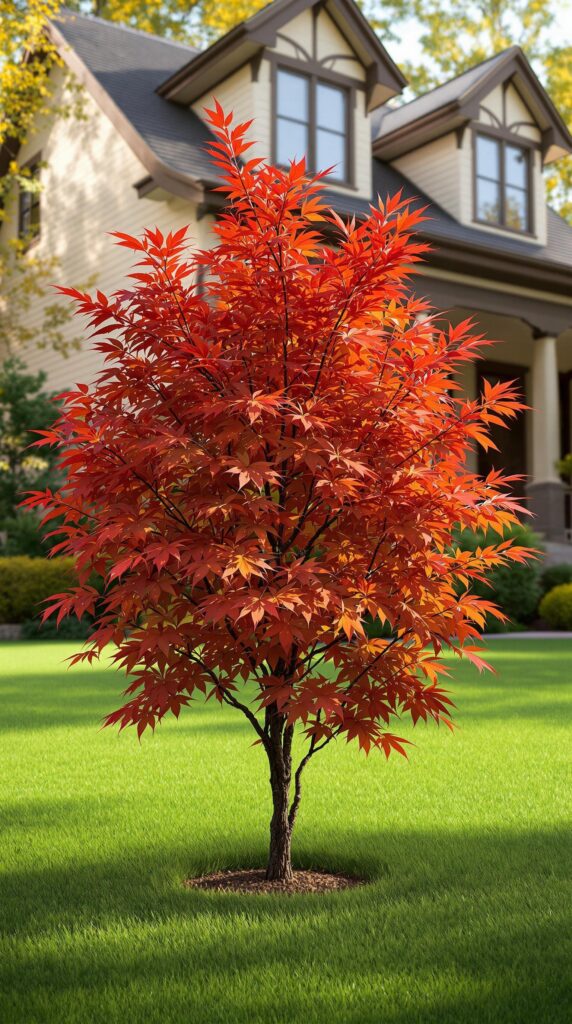
7. Rose (Rosa spp.)
Why It’s a Favorite:
Nothing says elegance like a rose. With climbing, shrub, and groundcover varieties, roses can be adapted to nearly any front-yard design.
- Suitability: Ideal for romantic or classic landscapes.
- Hardiness Zones: 4–9 (depending on variety)
- Special Attributes: Fragrant, long bloom period, attracts pollinators.
Pro Tip: Opt for disease-resistant varieties like Knock Out® roses for easy care and prolific blooms.
More Insight:
Modern rose cultivars offer amazing disease resistance and bloom longevity, making them far easier to maintain than old-fashioned types. Shrub roses are excellent for creating layered borders, while climbers can enhance trellises, porch posts, or fences. Provide full sun and good air circulation, and feed regularly to enjoy a cascade of color throughout the growing season.
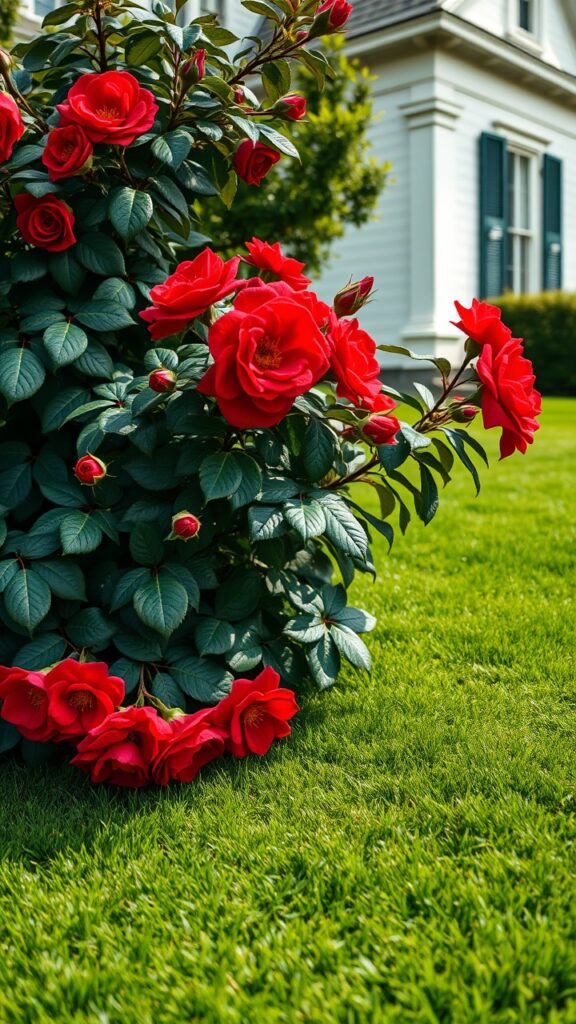
8. Weigela
Why It’s a Favorite:
Weigela adds a splash of tubular, nectar-rich flowers that hummingbirds can’t resist.
- Suitability: Works well as a specimen shrub or in mixed borders.
- Hardiness Zones: 4–8
- Special Attributes: Spring and summer blooms, pollinator-friendly, colorful foliage options.
Pro Tip: Some dwarf varieties stay compact and don’t require frequent pruning.
More Insight:
Weigela offers both form and function—its bell-shaped flowers are eye-catching, and newer cultivars like ‘Wine & Roses’ feature burgundy foliage for multi-season interest. It’s also a good choice for slopes or low-maintenance areas, where it can spread naturally. A light prune after flowering will keep it in shape and stimulate new growth.
9. Spirea
Why It’s a Favorite:
Spirea shrubs are cheerful and easygoing, with masses of blooms and a mounded growth habit.
- Suitability: Great along walkways or as a low hedge.
- Hardiness Zones: 3–8
- Special Attributes: Bloom in late spring, some varieties rebloom, deer-resistant.
Pro Tip: Trim back after blooming to encourage a second flush of flowers.
More Insight:
This adaptable shrub thrives in full sun and tolerates a wide range of soil types. It typically grows 2–4 feet tall, making it ideal for layering in borders or defining bed edges. Spirea’s neat form pairs well with ornamental grasses or evergreens. ‘Goldmound’ offers chartreuse foliage for added color even when not in bloom.
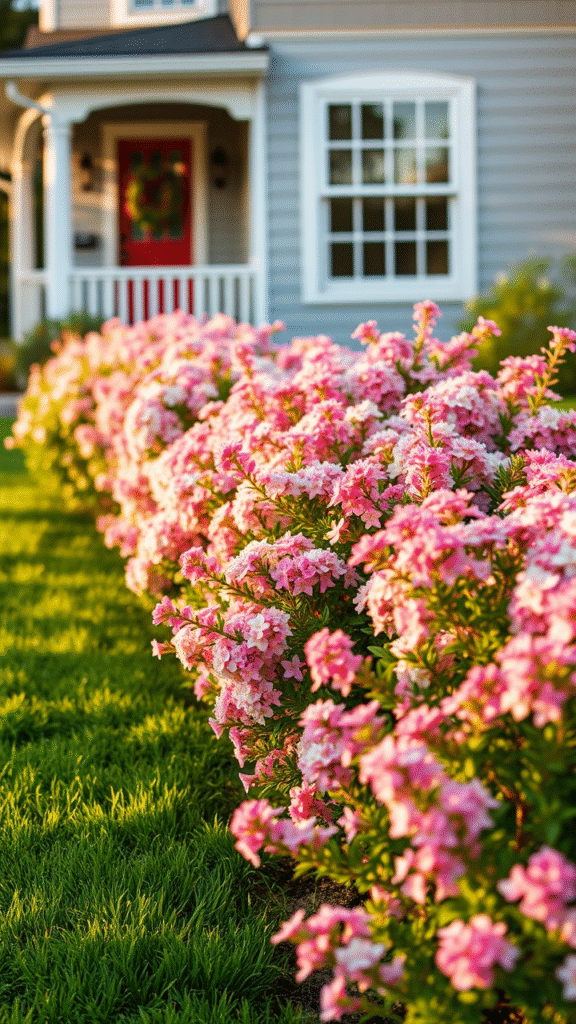
10. Bottlebrush (Callistemon)
Why It’s a Favorite:
Known for its striking, brush-like flowers, Bottlebrush is a standout in warmer climates.
- Suitability: Best for southern front yards with full sun.
- Hardiness Zones: 8–11
- Special Attributes: Evergreen, attracts hummingbirds, drought-tolerant.
Pro Tip: Use as a foundation planting with tropical flair in warmer zones.
More Insight:
Bottlebrush thrives in hot, dry conditions and offers vivid red flowers that bloom multiple times a year with proper care. It has a loose, airy growth habit that complements more structured plants. While not frost-hardy, it’s perfect for Mediterranean or desert-inspired front yards.
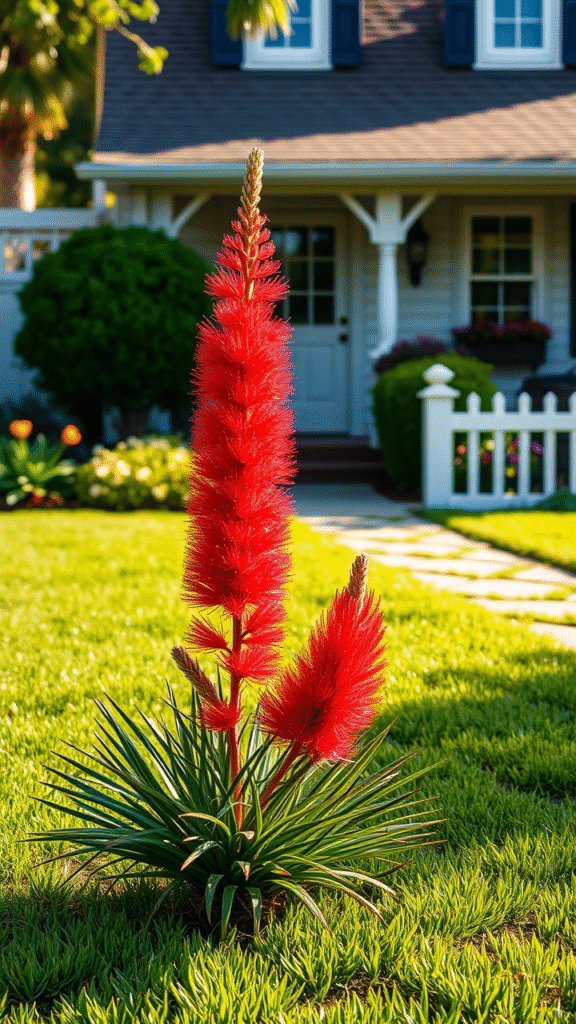
11. Yew (Taxus spp.)
Why It’s a Favorite:
Yews are ultra-dependable evergreens that can be shaped into hedges or left to grow naturally.
- Suitability: Perfect for formal landscaping or privacy screening.
- Hardiness Zones: 4–7
- Special Attributes: Year-round greenery, shade tolerant, easy to prune.
Pro Tip: Avoid planting in poorly drained soils; Yews prefer well-drained spots.
More Insight:
Yews tolerate deep shade better than many evergreens and respond well to heavy pruning. They’re ideal for foundation plantings where consistent structure is needed. Over time, yews can become large, so choose dwarf or slow-growing cultivars for smaller front yards.
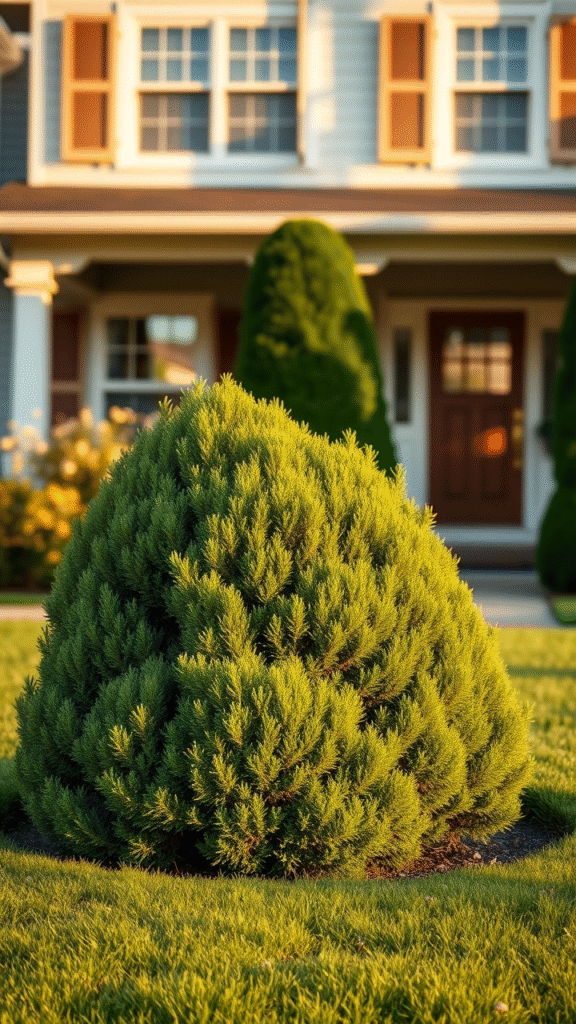
12. Holly (Ilex spp.)
Why It’s a Favorite:
With glossy green leaves and red berries, Holly is a festive addition that provides winter interest and structure.
- Suitability: Excellent foundation shrub or hedge.
- Hardiness Zones: 5–9
- Special Attributes: Evergreen, bird-friendly, some varieties are deer-resistant.
Pro Tip: Plant both male and female varieties if you want berries.
More Insight:
Holly’s dense, spiny leaves make it a great deterrent plant for windows and entryways. It can be shaped into pyramids or hedges and is a great winter performer. Try dwarf varieties like ‘Compacta’ for smaller spaces, or ‘Nellie R. Stevens’ for a larger, pyramidal form.
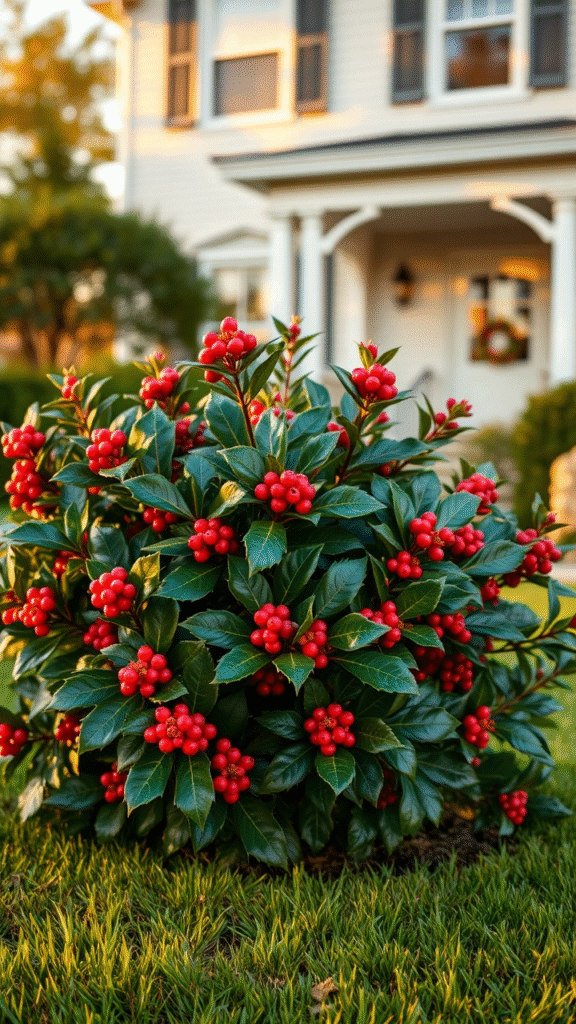
13. Camellia
Why It’s a Favorite:
Camellias bloom in late fall to early spring, offering rare color when most other plants are dormant.
- Suitability: Best for shaded front yards or woodland landscapes.
- Hardiness Zones: 7–9
- Special Attributes: Glossy foliage, long bloom time, shade tolerant.
Pro Tip: Camellias thrive in slightly acidic soil and sheltered spots protected from wind.
More Insight:
Camellias are often called the “queens of winter” for their unmatched beauty during cooler months. With varieties blooming in fall (Camellia sasanqua) or spring (Camellia japonica), you can extend your front yard’s flower show. Their upright growth habit and lustrous green leaves also make them perfect for formal gardens or as elegant evergreen anchors near the front porch. Mulching helps keep roots cool and moist.
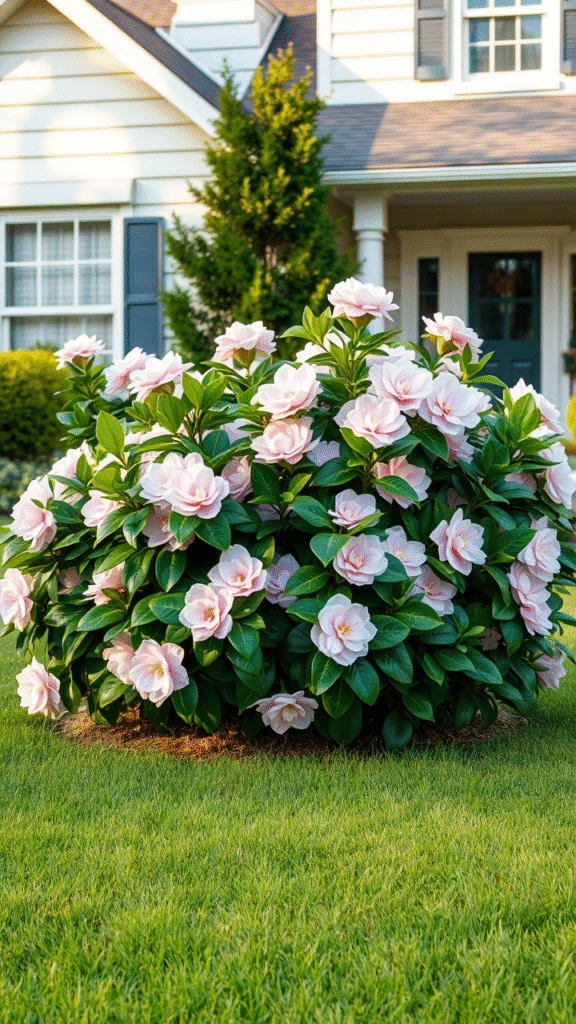
14. Dwarf Alberta Spruce
Why It’s a Favorite:
This compact conifer has a naturally symmetrical, pyramidal shape that adds a formal flair to entryways.
- Suitability: Excellent in containers or flanking steps and doorways.
- Hardiness Zones: 3–6
- Special Attributes: Evergreen, very slow growing, dense foliage.
Pro Tip: Protect from hot afternoon sun in warmer climates to prevent browning.
More Insight:
Growing only 2–4 inches per year, this slow-grower is excellent for small spaces or precise design areas. It maintains its Christmas tree shape without pruning, making it a low-maintenance option. Because of its sensitivity to heat, it performs best in cooler climates and appreciates consistent watering during dry spells. Try pairing with colorful annuals in containers for a year-round statement.
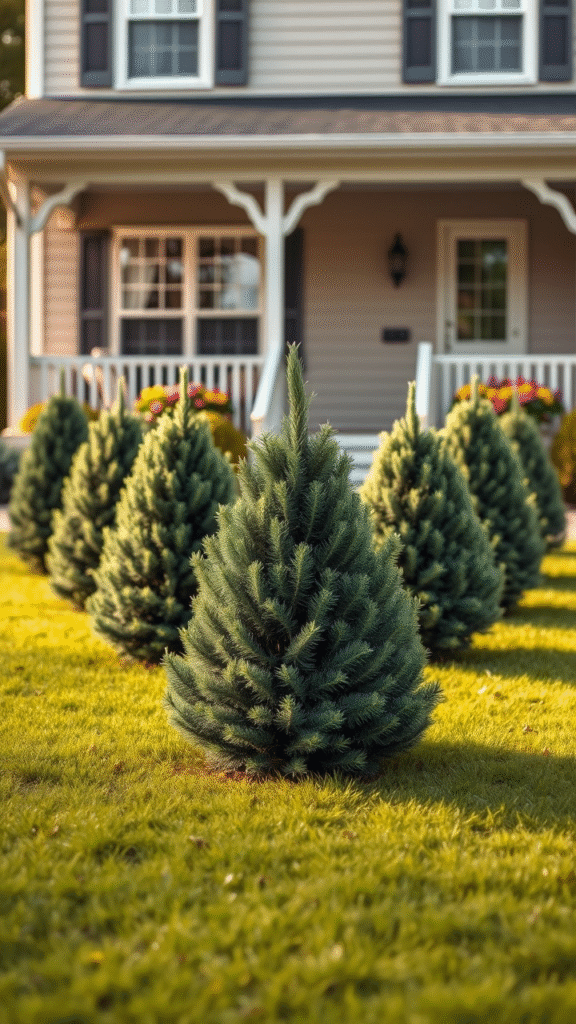
15. Smoke Bush (Cotinus coggygria)
Why It’s a Favorite:
Named for its airy, smoke-like flower clusters, this shrub also offers dramatic foliage in purple or burgundy hues.
- Suitability: Ideal as a bold specimen plant.
- Hardiness Zones: 5–9
- Special Attributes: Drought-tolerant, colorful foliage, unique flowers.
Pro Tip: Cut back in early spring to encourage fresh growth and keep its shape manageable.
More Insight:
Smoke Bush is perfect when you want a statement piece in your landscape. Its hazy, plume-like flowers in summer and vibrant fall foliage ensure it looks attractive for most of the year. Cultivars like ‘Royal Purple’ offer rich, dark leaves that contrast beautifully with green neighbors. It handles poor soils well and thrives in full sun, making it a low-maintenance but high-impact option.
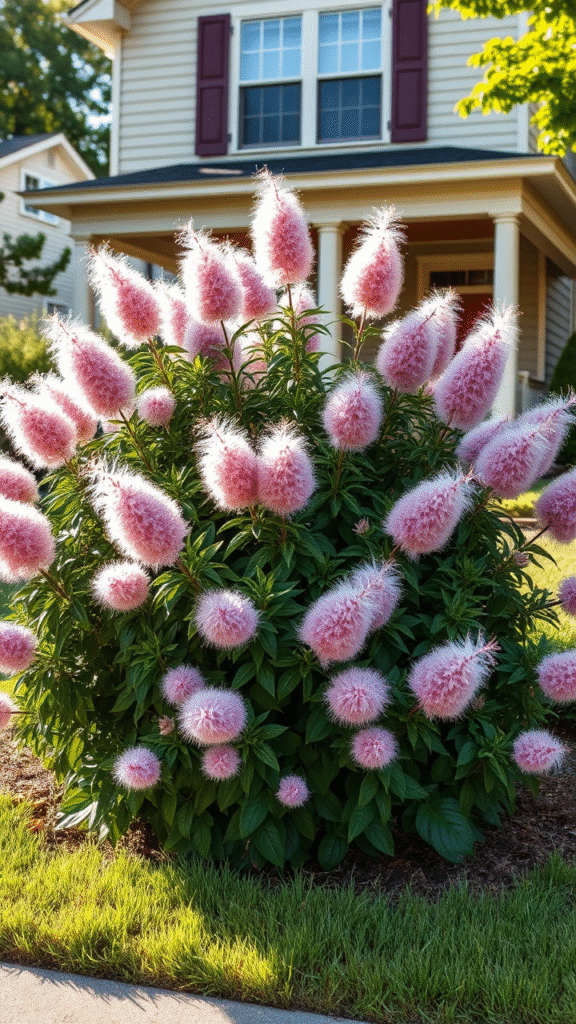
16. Rhododendron
Why It’s a Favorite:
Rhododendrons offer large, showy blooms in late spring and perform beautifully in part-shade locations.
- Suitability: Great for woodland-themed or naturalistic front yards.
- Hardiness Zones: 4–8
- Special Attributes: Evergreen varieties available, long bloom period, shade tolerant.
Pro Tip: They prefer acidic, well-draining soil—mulch with pine bark or needles to keep conditions ideal.
More Insight:
These shrubs can range from compact to large forms, making them adaptable for small beds or sweeping foundation plantings. Their bell-shaped flowers attract bees and add elegance under trees or along shaded foundations. Look for hardy varieties like ‘PJM’ that provide evergreen foliage and are more tolerant of cold than traditional types. Rhododendrons also look stunning when massed together in a shaded border.
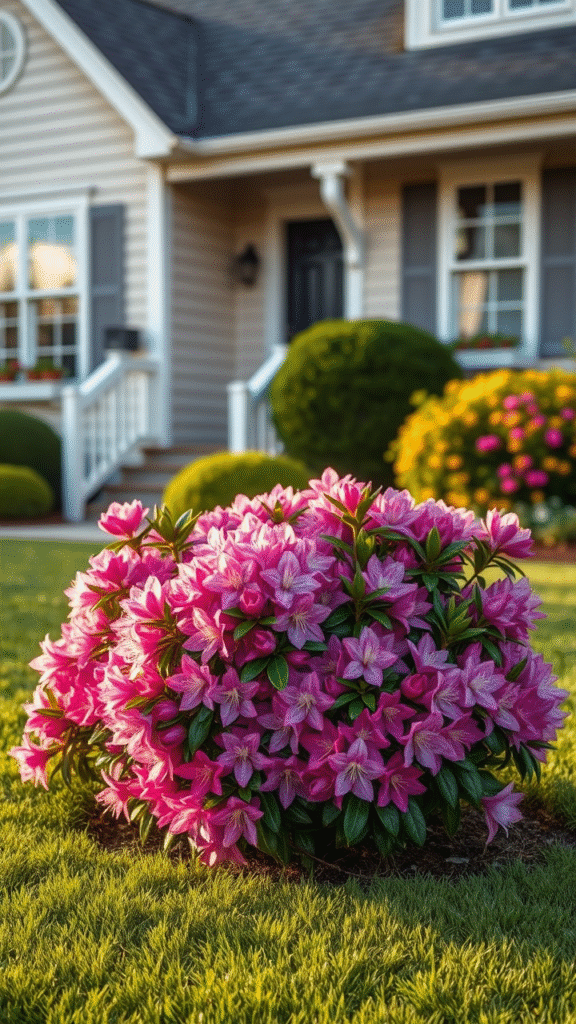
17. Bonus Pick: Gardenia
Why It’s a Favorite:
If you’re in the right climate, Gardenia is a must-have for its intoxicating fragrance and glossy green foliage.
- Suitability: Ideal near porches or windows where you can enjoy the scent.
- Hardiness Zones: 8–11
- Special Attributes: Fragrant white blooms, evergreen, thrives in partial shade.
Pro Tip: Gardenias need consistent moisture and appreciate some humidity—perfect for Southern landscapes.
More Insight:
Gardenias are highly ornamental and often planted near entryways, patios, or in front beds where their scent can be appreciated. The double blooms are striking against the dark green foliage. These shrubs prefer slightly acidic soil and benefit from regular feeding to support blooming. Gardenias are also fantastic for containers and do well in raised beds where drainage can be better controlled.
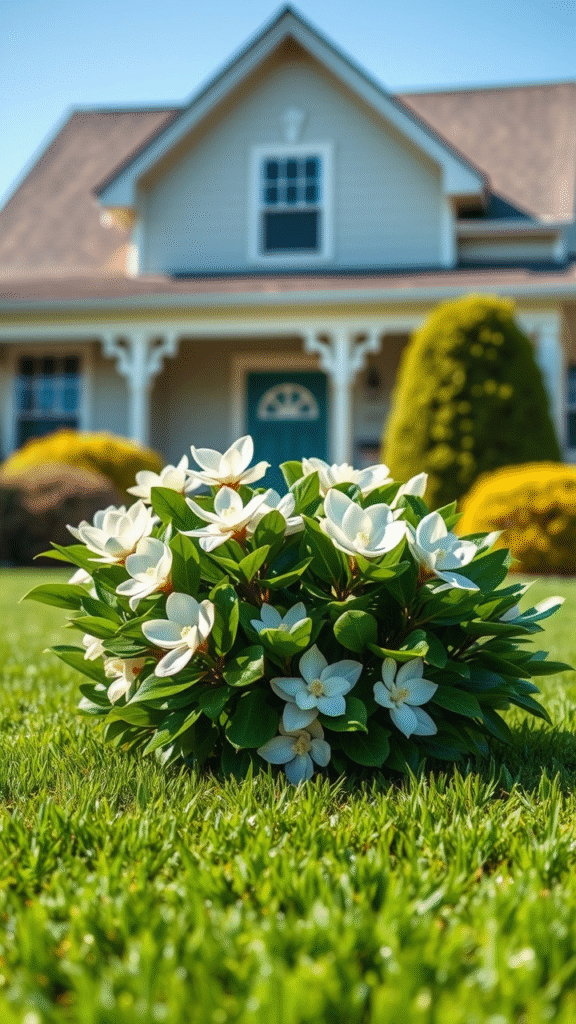
Final Thoughts: Design Your Dream Front Yard
Choosing the right shrubs for the front of your house is about more than just plant selection—it’s about creating a welcoming space that enhances your home’s charm and reflects your personality. Whether you’re drawn to the formal lines of boxwood and yew or prefer the romantic blooms of lilac and hydrangea, there’s a shrub on this list that will fit your climate, aesthetic, and maintenance preferences.
Don’t forget:
- Consider plant spacing and mature size when planting.
- Mix evergreen and deciduous varieties for year-round interest.
- Group shrubs with similar sun, soil, and water needs for easier care.
These 17 shrubs aren’t just visually appealing—they also bring scent, structure, and seasonal variety to your landscape. With thoughtful planning and the right mix, your front yard can become your home’s crown jewel. Let these standout shrubs inspire your next landscaping project—and get ready to turn heads from the curb!
